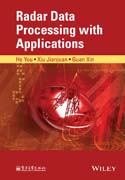
A systematic introduction to the theory, development and latest research results of radar data processing technology Presents both classical theory and development methods of radar data processing Provides state–of–the–art research results, including data processing for modern style radars, and tracking performance evaluation theory Includes coverage of performance evaluation, registration algorithm for Radar network, data processing of passive radar, pulse Doppler radar, and phased array radar Has applications for those engaged in information engineering, radar engineering, electronic countermeasures, infrared techniques, sonar techniques, and military command INDICE: About the Authors xiv .Preface xvi .1 Introduction 1 .1.1 Aim and Significance of Radar Data Processing 1 .1.2 Basic Concepts in Radar Data Processing 2 .1.3 Design Requirements and Main Technical Indexes of Radar Data Processors 9 .1.4 History and Present Situation of Research in Radar Data Processing Technology 12 .1.5 Scope and Outline of the Book 14 .2 Parameter Estimation 20 .2.1 Introduction 20 .2.2 The Concept of Parameter Estimation 20 .2.3 Four Basic Parameter Estimation Techniques 23 .2.4 Properties of Estimators 26 .2.5 Parameter Estimation of Static Vectors 28 .2.6 Summary 33 .3 Linear Filtering Approaches 34 .3.1 Introduction 34 .3.2 Kalman Filter 34 .3.3 Steady–State Kalman Filter 48 .3.4 Summary 52 .4 Nonlinear Filtering Approaches 53 .4.1 Introduction 53 .4.2 Extended Kalman Filter 53 .4.3 Unscented Kalman Filter 58 .4.4 Particle Filter 65 .4.5 Summary 71 .5 Measurement Preprocessing Techniques 72 .5.1 Introduction 72 .5.2 Time Registration 72 .5.3 Space Registration 75 .5.4 Radar Error Calibration Techniques 88 .5.5 Data Compression Techniques 89 .5.6 Summary 93 .6 Track Initiation in Multi–target Tracking 95 .6.1 Introduction 95 .6.2 The Shape and Size of Track Initiation Gates 96 .6.3 Track Initiation Algorithms 100 .6.4 Comparison and Analysis of Track Initiation Algorithms 109 .6.5 Discussion of Some Issues in Track Initiation 116 .6.6 Summary 117 .7 Maximum Likelihood Class Multi–target Data Association Methods 118 .7.1 Introduction 118 .7.2 Track–Splitting Algorithm 118 .7.3 Joint Maximum Likelihood Algorithm 123 .7.4 0 1 Integer Programming Algorithm 126 .7.5 Generalized Correlation Algorithm 130 .7.6 Summary 137 .8 Bayesian Multi–target Data Association Approach 138 .8.1 Introduction 138 .8.2 Nearest–Neighbor Algorithm 138 .8.3 Probabilistic Data Association Algorithm 141 .8.4 Integrated Probabilistic Data Association Algorithm 152 .8.5 Joint Probabilistic Data Association Algorithm 154 .8.6 Summary 167 .9 Tracking Maneuvering Targets 169 .9.1 Introduction 169 .9.2 Tracking Algorithm with Maneuver Detection 170 .9.3 Adaptive Tracking Algorithm 174 .9.4 Performance Comparison of Maneuvering Target Tracking Algorithms 189 .9.5 Summary 201 .10 Group Target Tracking 203 .10.1 Introduction 203 .10.2 Basic Methods for Track Initiation of the Group Target 204 .10.3 The Gray Fine Track Initiation Algorithm for Group Targets 214 .10.4 Centroid Group Tracking 233 .10.5 Formation Group Tracking 238 .10.6 Performance Analysis of Tracking Algorithms for Group Targets 240 .10.7 Summary 246 .11 Multi–target Track Termination Theory and Track Management 250 .11.1 Introduction 250 .11.2 Multi–target Track Termination Theory 250 .11.3 Track Management 258 .11.4 Summary 275 .12 Passive Radar Data Processing 276 .12.1 Introduction 276 .12.2 Advantages of Passive Radars 276 .12.3 Passive Radar Spatial Data Association 278 .12.4 Optimal Deployment of Direction–Finding Location 289 .12.5 Passive Location Based on TDOA Measurements 299 .12.6 Summary 303 .13 Pulse Doppler Radar Data Processing 304 .13.1 Introduction 304 .13.2 Overview of PD Radar Systems 304 .13.3 Typical Algorithms of PD Radar Tracking 307 .13.4 Performance Analysis on PD Radar Tracking Algorithms 321 .13.5 Summary 331 .14 Phased Array Radar Data Processing 332 .14.1 Introduction 332 .14.2 Characteristics and Major Indexes 333 .14.3 Structure and Working Procedure 334 .14.4 Data Processing 336 .14.5 Performance Analysis of the Adaptive Sampling Period Algorithm 355 .14.6 Summary 361 .15 Radar Network Error Registration Algorithm 362 .15.1 Introduction 362 .15.2 The Composition and Influence of Systematic Errors 362 .15.3 Fixed Radar Registration Algorithm 366 .15.4 Mobile Radar Registration Algorithm 380 .15.5 Summary 402 .16 Radar Network Data Processing 405 .16.1 Introduction 405 .16.2 Performance Evaluation Indexes of Radar Networks 406 .16.3 Data Processing of Monostatic Radar Networks 408 .16.4 Data Processing of Bistatic Radar Networks 413 .16.5 Data Processing of Multistatic Radar Networks 420 .16.6 Track Association 423 .16.7 Summary 426 .17 Evaluation of Radar Data Processing Performance 427 .17.1 Introduction 427 .17.2 Basic Terms 428 .17.3 Data Association Performance Evaluation 429 .17.4 Performance Evaluation of Tracking 432 .17.5 Evaluation of the Data Fusion Performance of Radar Networks 436 .17.6 Methods of Evaluating Radar Data Processing Algorithms 438 .17.7 Summary 440 .18 Radar Data Processing Simulation Technology 441 .18.1 Introduction 441 .18.2 Basis of System Simulation Technology 442 .18.3 Simulation of Radar Data Processing Algorithms 449 .18.4 Simulation Examples of Algorithms 457 .18.5 Summary 463 .19 Practical Application of Radar Data Processing 464 .19.1 Introduction 464 .19.2 Application in ATC Systems 464 .19.3 Application in Shipboard Navigation Radar 474 .19.4 Application in Shipboard Radar Clutter Suppression 476 .19.5 Application in Ground–Based Radar 480 .19.6 Applications in Shipboard Monitoring System 482 .19.7 Application in the Fleet Air Defense System 484 .19.8 Applications in AEW Radar 486 .19.9 Application in Air Warning Radar Network 492 .19.10 Application in Phased Array Radar 495 .19.11 Summary 498 .20 Review, Suggestions, and Outlook 499 .20.1 Introduction 499 .20.2 Review of Research Achievements 499 .20.3 Issues and Suggestions 502 .20.4 Outlook for Research Direction 505 .References 508 .Index 523
- ISBN: 978-1-118-95686-1
- Editorial: Wiley–Blackwell
- Encuadernacion: Cartoné
- Páginas: 560
- Fecha Publicación: 31/10/2016
- Nº Volúmenes: 1
- Idioma: Inglés
